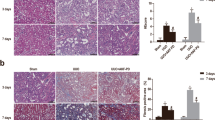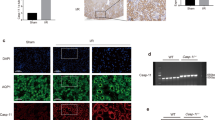Abstract
Acute kidney injury (AKI) induced by renal ischemia/reperfusion injury (IRI) is a severe clinical condition. ROS accumulation, antioxidant pathways deficiency, and inflammation are involved in IRI. Pioglitazone (Pio) exerts anti-inflammatory and antioxidant effects. The aim of this study was to explore the protective effects of pioglitazone against IRI-induced AKI. Pathogen-free Sprague–Dawley (SD) rats were arbitrarily divided into four groups: Sham operation group Control (CON) group, CON + Pio group, I/R + Saline group, and I/R + Pio group. In addition, HK-2 cells were subjected to hypoxia and reoxygenation to develop an H/R model for investigation of the protective mechanism of Pio. Pretreatment with pioglitazone in the model rats reduced urea nitrogen and creatinine levels, histopathological scores, and cytotoxicity after IRI. Pioglitazone treatment significantly attenuated renal cell apoptosis, decreased cytotoxicity, increased Bcl-2 expression, and downregulated Bax expression. Besides, the levels of ROS and inflammatory factors, including NLRP3, ASC, pro-IL-1β, pro-caspase-1, cleaved-caspase-1, TNF-α, IL-6, and IL-1β, in I/R rats and H/R cells were normalized by the pioglitazone treatment. Pioglitazone improved IRI-induced AKI by attenuating oxidative stress and NLRP3 inflammasome activation. Therefore, pioglitazone has the potential to serve as a novel agent for renal IRI treatment and prevention.






Similar content being viewed by others
Data availability
The data and material that support the findings of this study are available from the corresponding author upon reasonable request.
Abbreviations
- AKI:
-
Acute kidney injury
- I/R:
-
Ischemia/reperfusion
- NLRP3:
-
Nod-like receptor protein 3
- IRI:
-
Ischemia/reperfusion injury
- ROS:
-
Reactive oxygen species
- Pio:
-
Pioglitazone
- SD:
-
Sprague–Dawley
- CON:
-
Sham operation
- H/R:
-
Hypoxia/reoxygenation
- PPAR-γ:
-
Peroxisome proliferator-activated receptor-γ
- GST:
-
Glutathione transferase
- GSH:
-
Glutathione
- GSSG:
-
Oxidized glutathione
- SOD:
-
Superoxide dismutase
- HK-2:
-
Human kidney 2
- PBS:
-
Phosphate-buffered saline
- CCK-8:
-
Cell Counting Kit-8
References
Peerapornratana S, Manrique-Caballero CL, Gómez H, Kellum JA. Acute kidney injury from sepsis: current concepts, epidemiology, pathophysiology, prevention and treatment. Kidney Int. 2019;96(5):1083–99.
Gumbert SD, Kork F, Jackson ML, Vanga N, Ghebremichael SJ, Wang CY, et al. Perioperative acute kidney injury. Anesthesiology. 2020;132(1):180–204.
Medić B, Stojanović M, Rovčanin B, Kekić D, Škodrić SR, Jovanović GB, et al. Pioglitazone attenuates kidney injury in an experimental model of gentamicin-induced nephrotoxicity in rats. Sci Rep. 2019;9(7):13689.
Jha JC, Banal C, Chow BS, Cooper ME, Jandeleit-Dahm K. Diabetes and kidney disease: role of oxidative stress. Antioxid Redox Signal. 2016;25(12):657–84.
Zou G, Zhou Z, Xi X, Huang R, Hu H. Pioglitazone ameliorates renal ischemia-reperfusion injury via inhibition of NF-κB activation and inflammation in rats. Front Physiol. 2021;12: 707344.
Kaltenmeier C, Wang R, Popp B, Geller D, Tohme S, Yazdani HO. Role of immuno-inflammatory signals in liver ischemia-reperfusion injury. Cells. 2022;11(14):2222.
Pefanis A, Ierino FL, Murphy JM, Cowan PJ. Regulated necrosis in kidney ischemia-reperfusion injury. Kidney Int. 2019;96(2):291–301.
Su L, Zhang J, Gomez H, Kellum JA, Peng Z. Mitochondria ROS and mitophagy in acute kidney injury. Autophagy. 2023;19(2):401–14.
Zhang BH, Liu H, Yuan Y, Weng XD, Du Y, Chen H, et al. Knockdown of TRIM8 protects HK-2 cells against hypoxia/reoxygenation-induced injury by inhibiting oxidative stress-mediated apoptosis and pyroptosis via PI3K/Akt signal pathway. Drug Des Dev Ther. 2021;15:4973–83.
Liu W, Gan Y, Ding Y, Zhang L, Jiao X, Liu L, et al. Autophagy promotes GSDME-mediated pyroptosis via intrinsic and extrinsic apoptotic pathways in cobalt chloride-induced hypoxia reoxygenation-acute kidney injury. Ecotoxicol Environ Saf. 2022;242:113881.
Devchand PR, Liu T, Altman RB, FitzGerald GA, Schadt EE. The pioglitazone trek via human PPAR gamma: from discovery to a medicine at the FDA and beyond. Front Pharmacol. 2018;9:1093.
Richter B, Bandeira-Echtler E, Bergerhoff K, Clar C, Ebrahim SH. Pioglitazone for type 2 diabetes mellitus. Cochrane Database Syst Rev. 2006;2006(4):Cd006060.
Nesti L, Tricò D, Mengozzi A, Natali A. Rethinking pioglitazone as a cardioprotective agent: a new perspective on an overlooked drug. Cardiovasc Diabetol. 2021;20(1):109.
Yi HJ, Lee JE, Lee DH, Kim YI, Cho CB, Kim IS, et al. The role of NLRP3 in traumatic brain injury and its regulation by pioglitazone. J Neurosurg. 2019. https://doi.org/10.3171/2019.6.JNS1954.
Zhang H, Huang C, Zhang D, Zhu Y. Pioglitazone protects against hypoxia-induced cardiomyocyte apoptosis through inhibiting NLRP3/caspase-1 pathway in vivo and in vitro. Int Heart J. 2022;63(5):893–903.
Chen W, Xi X, Zhang S, Zou C, Kuang R, Ye Z, et al. Pioglitazone Protects against renal ischemia-reperfusion injury via the AMP-activated protein kinase-regulated autophagy pathway. Front Pharmacol. 2018;9:851.
Zou C, Zhou Z, Tu Y, Wang W, Chen T, Hu H. Pioglitazone attenuates reoxygenation injury in renal tubular NRK-52E cells exposed to high glucose via inhibiting oxidative stress and endoplasmic reticulum stress. Front Pharmacol. 2019;10:1607.
Acar M, Sayhan Kaplan H, Erdem AF, Tomak Y, Turan G, Özdin M. Effects of dexmedetomidine on new oxidative stress markers on renal ischaemia-reperfusion injury in rats: thiol/disulphide homeostasis and the ischaemia-modified albumin. Arch Physiol Biochem. 2022;128(4):1115–20.
Choi HY, Moon SJ, Ratliff BB, Ahn SH, Jung A, Lee M, et al. Microparticles from kidney-derived mesenchymal stem cells act as carriers of proangiogenic signals and contribute to recovery from acute kidney injury. PLoS ONE. 2014;9(2): e87853.
Zheng Z, Xu K, Li C, Qi C, Fang Y, Zhu N, et al. NLRP3 associated with chronic kidney disease progression after ischemia/reperfusion-induced acute kidney injury. Cell death discovery. 2021;7(1):324.
Hu H, Zou C, Xi X, Shi Z, Wang G, Huang X. Protective effects of pioglitazone on renal ischemia-reperfusion injury in mice. J Surg Res. 2012;178(1):460–5.
Wolf P, Schoeniger A, Edlich F. Pro-apoptotic complexes of BAX and BAK on the outer mitochondrial membrane. Biochim Biophys Acta. 2022;1869(10): 119317.
Eskandari E, Eaves CJ. Paradoxical roles of caspase-3 in regulating cell survival, proliferation, and tumorigenesis. J Cell Biol. 2022;221(6):e202201159.
Minutoli L, Puzzolo D, Rinaldi M, Irrera N, Marini H, Arcoraci V, et al. ROS-mediated NLRP3 inflammasome activation in brain, heart, kidney, and testis ischemia/reperfusion injury. Oxid Med Cell Longev. 2016;2016:2183026.
Sharma BR, Kanneganti TD. NLRP3 inflammasome in cancer and metabolic diseases. Nat Immunol. 2021;22(5):550–9.
Tapia-Abellán A, Angosto-Bazarra D, Martínez-Banaclocha H, de Torre-Minguela C, Cerón-Carrasco JP, Pérez-Sánchez H, et al. MCC950 closes the active conformation of NLRP3 to an inactive state. Nat Chem Biol. 2019;15(6):560–4.
Sharif H, Wang L, Wang WL, Magupalli VG, Andreeva L, Qiao Q, et al. Structural mechanism for NEK7-licensed activation of NLRP3 inflammasome. Nature. 2019;570(7761):338–43.
Zhao M, Wang Y, Li L, Liu S, Wang C, Yuan Y, et al. Mitochondrial ROS promote mitochondrial dysfunction and inflammation in ischemic acute kidney injury by disrupting TFAM-mediated mtDNA maintenance. Theranostics. 2021;11(4):1845–63.
Tang C, Hu Y, Gao J, Jiang J, Shi S, Wang J, et al. Dexmedetomidine pretreatment attenuates myocardial ischemia reperfusion induced acute kidney injury and endoplasmic reticulum stress in human and rat. Life Sci. 2020;257: 118004.
Yang CC, Sung PH, Chiang JY, Chai HT, Chen CH, Chu YC, et al. Combined tacrolimus and melatonin effectively protected kidney against acute ischemia-reperfusion injury. FASEB J. 2021;35(6): e21661.
Liu X, Zhang P, Song X, Cui H, Shen W. PPARγ mediates protective effect against hepatic ischemia/reperfusion injury via NF-κB pathway. J Invest Surg. 2022;35(8):1648–59.
DeFronzo RA, Inzucchi S, Abdul-Ghani M, Nissen SE. Pioglitazone: the forgotten, cost-effective cardioprotective drug for type 2 diabetes. Diab Vasc Dis Res. 2019;16(2):133–43.
Betz B, Schneider R, Kress T, Schick MA, Wanner C, Sauvant C. Rosiglitazone affects nitric oxide synthases and improves renal outcome in a rat model of severe ischemia/reperfusion injury. PPAR Res. 2012;2012: 219319.
Reel B, Guzeloglu M, Bagriyanik A, Atmaca S, Aykut K, Albayrak G, et al. The effects of PPAR-γ agonist pioglitazone on renal ischemia/reperfusion injury in rats. J Surg Res. 2013;182(1):176–84.
Ali SM, Khalifa H, Mostafa DK, El Sharkawy A. Suppression of connective tissue growth factor mediates the renoprotective effect of sitagliptin rather than pioglitazone in type 2 diabetes mellitus. Life Sci. 2016;153:180–7.
Xue Y, Enosi Tuipulotu D, Tan WH, Kay C, Man SM. Emerging activators and regulators of inflammasomes and pyroptosis. Trends Immunol. 2019;40(11):1035–52.
Xiao YD, Huang YY, Wang HX, Wu Y, Leng Y, Liu M, et al. Thioredoxin-interacting protein mediates NLRP3 inflammasome activation involved in the susceptibility to ischemic acute kidney injury in diabetes. Oxid Med Cell Longev. 2016;2016:2386068.
Tang TT, Lv LL, Pan MM, Wen Y, Wang B, Li ZL, et al. Hydroxychloroquine attenuates renal ischemia/reperfusion injury by inhibiting cathepsin mediated NLRP3 inflammasome activation. Cell Death Dis. 2018;9(3):351.
Zhang YL, Wang RB, Li WY, Xia FZ, Liu L. Pioglitazone ameliorates retinal ischemia/reperfusion injury via suppressing NLRP3 inflammasome activities. Int J Ophthalmol. 2017;10(12):1812–8.
Acknowledgements
The graphical abstracts were created with BioRender software (BioRender.com).
Funding
This work was supported by the Natural Science Foundation of China (No. 82160371 to J.Z., No.82100869 and No.82360162 to P.Y.); Natural Science Foundation in Jiangxi Province grant (No.20212BAB216047 to P.Y., No.20224ACB216009 and No. 20212BAB216051 to J.Z.); the Jiangxi Province Thousands of Plans (No. jxsq2023201105 to P.Y.); Young Elite Scientists Sponsorship Program by JXAST (No. 2023QT05 to J.Z.); and the Hengrui Diabetes Metabolism Research Fund (No. Z-2017-26-2202-4 to P.Y.).
Author information
Authors and Affiliations
Contributions
Zhenfeng Ye and Jing Zhang: reviewing, methodology, funding acquisition. Zhou Xu and Zhangwang Li: writing—original draft preparation. Gaomin Huang and Bin Tong: visualization and investigation. Panpan Xia and Yunfeng Shen: supervision. Honglin Hu and Jianyong Ma: software and validation. Peng Yu and Xiaoqing Xi: conceptualization and funding.
Corresponding authors
Ethics declarations
Conflict of interest
The authors declare that the research was conducted in the absence of any commercial or financial relationships that could be construed as a potential conflict of interest.
Ethical statement
All animal experiments were approved by the Ethical Committee on Animal Experiments in the Second Affiliate Hospital of Nanchang University (NO.: Review [2019] No. (033); ethical number: NCULAE-20221121086), in compliance with Chinese national or institutional guidelines for the care and use of animals.
Additional information
Publisher's Note
Springer Nature remains neutral with regard to jurisdictional claims in published maps and institutional affiliations.
Supplementary Information
Below is the link to the electronic supplementary material.
Rights and permissions
Springer Nature or its licensor (e.g. a society or other partner) holds exclusive rights to this article under a publishing agreement with the author(s) or other rightsholder(s); author self-archiving of the accepted manuscript version of this article is solely governed by the terms of such publishing agreement and applicable law.
About this article
Cite this article
Ye, Z., Zhang, J., Xu, Z. et al. Pioglitazone ameliorates ischemia/reperfusion-induced acute kidney injury via oxidative stress attenuation and NLRP3 inflammasome. Human Cell (2024). https://doi.org/10.1007/s13577-024-01059-w
Received:
Accepted:
Published:
DOI: https://doi.org/10.1007/s13577-024-01059-w




